When identifying the era of your furniture there are often factors to consider, this includes the aesthetic style, the craftsmanship and the variety of wood. This article on how to identify antique furniture will cover some of the most popular periods and the signs and features you may notice when investigating furniture in your care, or prior to the purchase of a new chair, table, cabinet or more unusual design.
 Above: chair designs from the 18th century to the 20th century
Above: chair designs from the 18th century to the 20th century
Understanding the era and materials of your furniture is important, as it will help to dictate the way that it is cared for and acknowledge the unique vulnerabilities it may face due to age and design. Sometimes this may not be as obvious as you may assume, as an older piece which has survived for many centuries may in fact be more stable than a piece created at the turn of the 20th century – much of this depends on materials and the manufacturing process.
 Above: a 19th century side table contrasted with a 20th century style
Above: a 19th century side table contrasted with a 20th century style
We hope that this guide will assist you in caring for your furniture, as well as getting to know more about the era in which it was created.
Renaissance period: Tudor, Elizabethan and Jacobean 1509 – 1690
This 200 year period includes the rise of an artistic era dominated by the culture and design of the renaissance through to the beginning of the baroque. Whilst earlier Tudor designs are often crafted from solid wood and have a focus on the form above decorations, it was during the reign of Elizabeth I that British furniture can be defined as a specific decorative style which is set apart from the continental renaissance of the same period. Whilst the Italian and French styles of the era are still influential, we can see some charming characteristics which are predominantly found in 16th and 17th century British designs.
 Above: an example of a late renaissance living space recreated in the Minneapolis Institute of Arts, the oak panels date to 1600
Above: an example of a late renaissance living space recreated in the Minneapolis Institute of Arts, the oak panels date to 1600
Early Tudor furniture veers more towards gothic aesthetics of preceding decades, with very few pieces created for the home. A typical Tudor home, even for those who were wealthy enough to afford such items, would not have more than bed stands, tables, or chests – there were no intricate pieces we may think of today such as fine cabinets and drawers. Chairs are very rare from this era and would more likely have been reserved for the lord of the manor, with benches and stools for guests. Tudor furniture is often a solid form with some carved decorations, such as a Gothic linenfold. The most obvious sign that your furniture is connected to the Tudors may appear in the form of a carved Tudor rose (a combined rose representing York and Lancaster).
 Above: grape motif carved on a 16th century British stool
Above: grape motif carved on a 16th century British stool
Unlike smooth and delicate continental features of the European renaissance, Elizabethan and Jacobean furniture tends to display more of a coarse and handcrafted appearance when it comes to decoration. The ornamental elements are predominantly gothic, but can also feature classical and heraldic details. These unique parts of the furniture design may include medallions, human features, floral and botanical elements, animals, or fruits. The extremities of Elizabethan furniture often have bulbous features, such as a rounded, barrel or acorn-like shape appearing halfway up the leg of a table, or rounded features covering the entire length, making them both sturdy and unique in their appearance.
 Above: a 16th century oak livery cupboard from 1585
Above: a 16th century oak livery cupboard from 1585
The most common type of wood in early British furniture is oak, due to its predominance and local cultivation. Whilst oak is naturally either a light beige or brown, it was often stained for a darker appearance. You may also find walnut furniture from the 16th and 17th centuries, as well as items with unique inlays from many more tree varieties. Due to the strength of oak, pieces of Elizabethan and Jacobean furniture survive today due to a strong resistance to rot and woodworm, their ongoing stability also shows a skill of craftsmanship from this period.
 Above: a Dutch or Flemish oak panel, late 16th century
Above: a Dutch or Flemish oak panel, late 16th century
Popular furniture from the Elizabethan and Jacobean periods include long dining or side tables, large chests, and an increasing amount of cabinets. The most famous examples are often four post beds with intricate designs, though most of these now reside in museums due to their cultural and artistic importance.
 Above: an Elizabethan oak document box, 1603
Above: an Elizabethan oak document box, 1603
Whilst renaissance furniture is hundreds of years old, the surviving pieces have often remained intact due to their strong craftsmanship, timber and design techniques – however it is important that their environment (humidity and temperature control) and home care is maintained adequately by professional and knowledgeable skills to ensure longevity.
 Above: a selection of 17th century chairs
Above: a selection of 17th century chairs
Anglo-Dutch baroque period: William & Mary, Queen Anne 1689 – 1755
This period displays more inspiration from European neighbours, especially that of the Dutch influence which came over with William of Orange in the 1680s. However, this Dutch preference was itself influenced by the French and the court of Louis XIV, making it a unique mixture of styles. This was compacted by the fact many French furniture designers found themselves in exile due to political changes in 1685, bringing to England their skill in Louis XVI designs – this included Daniel Marot, who came with William’s court – Marot’s work became a defining influence of the era.
 Above: a chair by Thomas Roberts in the style of Daniel Marot, 1689
Above: a chair by Thomas Roberts in the style of Daniel Marot, 1689
Unlike the solid and less fluid designs of the Tudor and renaissance periods, William & Mary furniture sits more comfortably in an interior as we might expect today and focuses far more on exhibiting beauty above the pure functionality of the past. Many elements appear slimmer and curved or scrolled, such as chair legs. Upholstery is more commonplace, though sometimes just on the seat of a chair rather than the back, which remains solid or decorative carved wood. In this era there is also far more use of veneer work, marquetry and high shine finishes.
 Above: high chest cabinets in William and Mary / Queen Anne styles
Above: high chest cabinets in William and Mary / Queen Anne styles
During the baroque period the types of different furniture became more vast and extravagant, it was in the 17th and 18th centuries that cabinet makers evolved their skills in making intricate designs with far more features. Under Queen Anne, cabinets were important new features of a home which could both display and keep safe ever-growing collections of porcelain.
 Above: early 18th century chairs with aspects of the Queen Anne style
Above: early 18th century chairs with aspects of the Queen Anne style
Oak is still a predominant timber used in this period, but many pieces may have been veneered or inlaid with different types to get decorative tones and effects. Pine and walnut were also popular, though many pieces would have been treated with a lacquer or stain for a shining finish. Not all lacquered pieces still have this bright appearance today due to their age, but this can be restored in our studio with traditional techniques.
 Above: a chair, settee, and armchair in the Queen Anne Style
Above: a chair, settee, and armchair in the Queen Anne Style
Heavily varnished or lacquer surfaces can cloud up due to contact with moisture, so it is important to only use wax or a dry cloth if you are uncertain of an item’s materials or vulnerabilities – it is also important to keep the relative humidity at an even level in the surrounding environment, not too dry and not too moist, around 40%-60%.
For a full history of chair design from ancient history to the 20th century, you can read our article here.
Georgian period: Chippendale 1750 – 1790
During the Georgian period the influence of Thomas Chippendale is central to furniture design. Much of this period can come under the grand artistic genres of baroque and rococo, but later designs saw a reassurance of gothic features and even a Chinese inspiration. Thomas Chippendale published his book entitled ‘The Gentleman and Cabinet-Maker’s Director’ in 1753 and this was culturally significant not only in British design, but also in Europe and North America – meaning that you may find very similar designs from vastly different locations.
 Above: examples of Chippendale furniture with upholstery including an armchair, two side chairs and a fireplace screen, all dating to the 18th century
Above: examples of Chippendale furniture with upholstery including an armchair, two side chairs and a fireplace screen, all dating to the 18th century
Chippendale furniture can be defined in a number of ways, a classic shape associated with such designs is in the cabriole legs (a bending line with one upper and lower curve) though over a span of changing fashion Chippendale can in fact be recognised with any of the following legs and feet: club, spade, lions paw, or ball and claw. Legs on later Chippendale furniture may appear more square. Most chairs in this style have silk upholstery (though this may have been updated and modernised over time) with backs that have a yoked shape. Finally, the back of a chair often has a delicate ribbon carving.
 Above: a selection of chair designs by Thomas Chippendale from 1753 including two armchairs with chinoiserie upholstery
Above: a selection of chair designs by Thomas Chippendale from 1753 including two armchairs with chinoiserie upholstery
Mahogany is often the wood of choice for Chippendale furniture, but less costly timber and materials may have been used over time including maple, walnut and cherry. The ornate style of Chippendale can still be found in reproductions up to the modern day, meaning that identifying the era and age of the wood is important in understanding the history and delicacy of the piece. Mahogany is usually a defining factor of this, as well as the craftsmanship of older pieces which may differ from handcrafted techniques of the 18th century through to increasingly factory manufactured furniture from the 19th and 20th centuries. Later reproductions also seem to be stained to mimic the earlier mahogany timber, so looking on an untreated area or more closely at the woodgrain may help in identification.
 Above: a selection of furniture influenced by Thomas Chippendale’s Gentleman and Cabinet Maker’s Director
Above: a selection of furniture influenced by Thomas Chippendale’s Gentleman and Cabinet Maker’s Director
The fine joinery of Chippendale furniture may be a weak point over time, loosening through heavy usage or slight warping due to atmospheric conditions. Breakages in Chippendale furniture can be treated by our professional team with era-appropriate repairs. If you have a highly valuable or rare piece of original Chippendale, we recommend that it is not used as an everyday item in the home and preserved for display value – especially if it has delicate or important upholstery.
You can learn more about Chippendale, including how to identify his work, in our full article here. For more information on the rococo period in art and design, please click here.
 Above: our furniture restoration specialist restoring a herringbone veneer detail to a bureau with Chippendale features
Above: our furniture restoration specialist restoring a herringbone veneer detail to a bureau with Chippendale features
Neoclassical period: regency and empire style 1750 – 1835
Neoclassicism stemmed from a philosophically perfect idea of ancient Greece and Rome, encouraged by an ever-increasing interest in archeological finds such as the remains of Pompeii which were uncovered in 1748. The enlightenment across Europe also saw the rise of the printing press and easily accessible texts of classical antiquity which inspired both art and design. Neoclassicism can also be seen as a continuation of a dominant imperial culture, of which many royal families and members of the aristocracy saw themselves as a part of. During the Regency period this can be seen both in clothing and interior design – in some cases ancient Greek, Roman, or Egyptian furniture was reproduced as a pure copy or drew strong inspiration.
 Above: a Russian settee from 1803 and an American card table attributed to Charles-Honoré Lannuier from 1810-19
Above: a Russian settee from 1803 and an American card table attributed to Charles-Honoré Lannuier from 1810-19
Neoclassical furniture may at first appear more restrained in terms of overall decoration. Ancient ideas of perfect lines and shapes were important, encouraging craftsmen and designers to focus on the beauty of elegant, slim lines. Hints to classical art or architecture may also be present. Whilst earlier pieces may retain the gilt surfaces popular in the 18th century, stained wood and veneers – including tropical timber such as ebony and mahogany – can be found on many examples.
 Above: three items attributed to famous Neoclassical designers including Charles-Honoré Lannuier, Robert Adam and Duncan Phyfe
Above: three items attributed to famous Neoclassical designers including Charles-Honoré Lannuier, Robert Adam and Duncan Phyfe
French polishing became dominant at the beginning of the 19th century. Due to this, specialist varieties of wood could be used to produce unique and beautiful surfaces. Timber was cultivated especially for a unique pattern, birds eye maple was extremely popular due to it’s speckled appearance. Birds eye maple is created from a sugar maple, which has been purposely grown in shaded and unnatural conditions. The environment causes it to create constant new buds reaching for sunlight, only to have them reabsorbed, leaving an unusual and much sought-after pattern. French polish may have deteriorated over the hundreds of years since its original application, leaving a dull and vulnerable surface – and veneers are extremely delicate when it comes to water damage and warping. If you spot these issues it is recommended that you get in touch with our team to discuss professional care.
 Above: a group of Austrian neoclassical chairs with walnut veneers, 1830
Above: a group of Austrian neoclassical chairs with walnut veneers, 1830
Victorian & Edwardian period: Modern Gothic and Arts & Crafts 1835 – 1910
With an evermore accessible market for furniture in not only high society homes, many pieces of the Victorian era may have been produced as purely functional and later in the period as easily manufactured pieces for a growing commercial market. Of the pieces which were decorative and an aesthetic part of a Victorian home, the influence of gothic revival is prevalent, followed by an interest in traditional techniques as opposed to industrial design in the arts and crafts movement.
 Above: a selection of 19th century chair designs from different decades
Above: a selection of 19th century chair designs from different decades
During the 19th century revival also occurred in the popular use of oak, though you may also come across teak, satin birch, and pitch pine. More exotic woods from the rest of the world may have also been more easily accessible in this period. Some timber is telling of the new industrial age, as varieties such as pollard oak, which has a unique pattern due to fungus growth. Veneer work could only make use of pollard oak by using new cutting techniques made available by the industrial revolution. In some cases you may even find furniture created from papier-mache due to the use of specialist moulding equipment.
 Above: various Victorian side chairs and an étagère made of lacquered papier-mâchè
Above: various Victorian side chairs and an étagère made of lacquered papier-mâchè
Modern gothic furniture can be determined through the use of angles and details reminiscent of medieval cathedrals, including high pointed angles. However, the Victorians had no single style as the change in fashions became more frequent and individual in taste. During this period you may also come across designs which copy some of the genres we have mentioned previously, including rococo and tudor revival. Therefore Victorian furniture may seem to throw you off at first due to mimicry, but a close look at the joinery and craftsmanship may point you in the right direction. Look for signs of machine cut lines or effects which may have only been made possible by later centuries. The inclusion of heavily aesthetic flowers, bows or vined areas may also point to a Victorian style, as well as heavy drapery.
 Above: gothic revival furniture and a 19th century birdhouse in the shape of a gothic style home
Above: gothic revival furniture and a 19th century birdhouse in the shape of a gothic style home
The arts and crafts movement sought to create a modern interior design which was both beautiful and simple, taking into account everything from the furniture to the ornaments and fixtures. Famous names in this area include William de Morgan, Philip Webb, Charles Voysey, William Morris, and Charles Robert Ashbee. The central features of arts and craft furniture include the use of nature, such as oak leaves or flora. However, they often value functionality over an abundance of decoration and aesthetic choices. Arts and crafts furniture may also show exposed pins and joinery and use local timber. You may find that these pieces come under a typical farmhouse or country style, displaying great technique in construction whilst not being overly extravagant or expensive to their original market.
 Above: examples of arts and crafts style furniture including an oak linen press, a William Morris cabinet with artwork by Edward Burne-Jones and a cabinet attributed to George Walton
Above: examples of arts and crafts style furniture including an oak linen press, a William Morris cabinet with artwork by Edward Burne-Jones and a cabinet attributed to George Walton
20th century: Scandinavian and Mid-century Modern 1930 – 1969
The introduction of different styles and materials in the 20th century meant that wooden furniture was not always as popular, many items from this period may be plastic, metal or have a wide variety of different upholstery from traditional weaves to new synthetic fabrics. The sleek and nostalgic designs from the 1930s onwards still have a huge appeal today and can be found in many homes.
 Above: examples of mid-century Scandinavian furniture designs including a lounge chair and dining set
Above: examples of mid-century Scandinavian furniture designs including a lounge chair and dining set
Early 20th century furniture from Scandinavia was a defining influence of the period, this saw a pull towards minimalism and used the principles of the bauhaus movement. This was compelled by the world wars, which saw even more need for well-crafted functionality and manufacturing over purely aesthetic furniture for the modern home. Affordable furniture was also important for the booming consumer market which needed to cater for all aspects of society.
 Above: mid-century home interiors featuring classic pieces of furniture from this era
Above: mid-century home interiors featuring classic pieces of furniture from this era
Genuine wooden designs from this period are most often made from solid teak, rosewood or walnut. Higher end chairs may have been cut from one piece or have a streamlined, flowing design, whilst others are simple but have hints to free flowing curves in a wishbone shape or rounded edges. By contrast, some shapes have more of a futuristic look and use angles to define a strong aesthetic. Famous furniture influenced by or originally from this period include tulip chairs and egg chairs, as well as compartmentalised shelving units or room dividers and curving or cornered settees.
 Above: a sofa designed by Herman Miller for an airline company, 1965
Above: a sofa designed by Herman Miller for an airline company, 1965
The fashion and possibility of high value for early to mid 20th century furniture means that following a disaster they should always be considered for assessment and restoration in the way that any older antique would be. Due to the original low value of such furniture and the fact that they were designed for everyday use, they may in fact be in poorer condition than an extravagant rococo piece. Common items such as coffee tables may have faced decades of staining from cups and mugs, as well as accidental damage or constant wear from multiple generations. This type of deterioration can be restored in our studio, and whilst some scratches or dents to the wood may be difficult to absolve, the original finish of the surfaces can be brought back with era-appropriate conditioning and finishes.
 Above: two mid century living rooms
Above: two mid century living rooms
How can we help?
Our team of furniture experts specialises in care based on the age of the piece, this includes traditional repairs with sourcing of era-appropriate timber and elements where required. They can also treat furniture with French polish and a variety of protective, historically accurate and visually pleasing finishes.
To make contact if you need help to identify antique furniture or would like our furniture restoration services, please email us via [email protected] or call 0207 112 7576

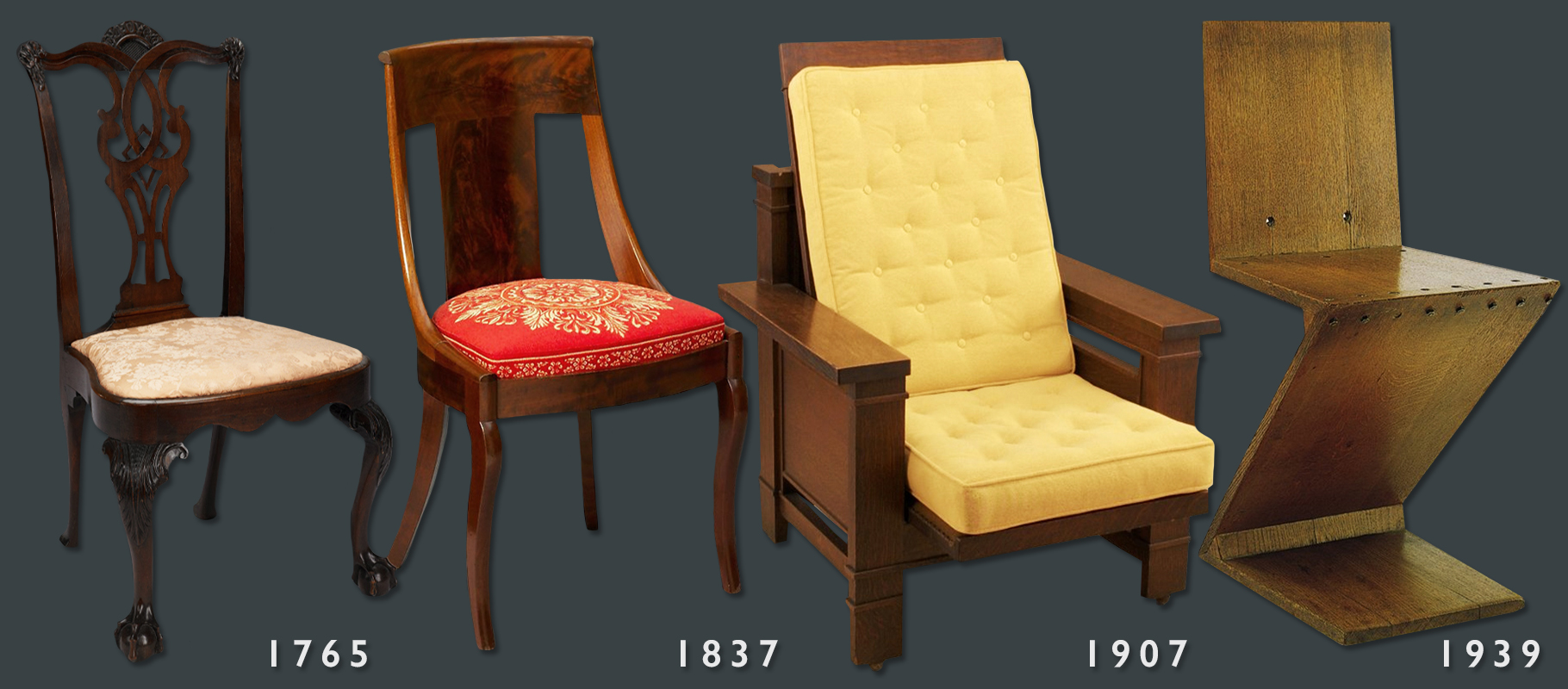 Above: chair designs from the 18th century to the 20th century
Above: chair designs from the 18th century to the 20th century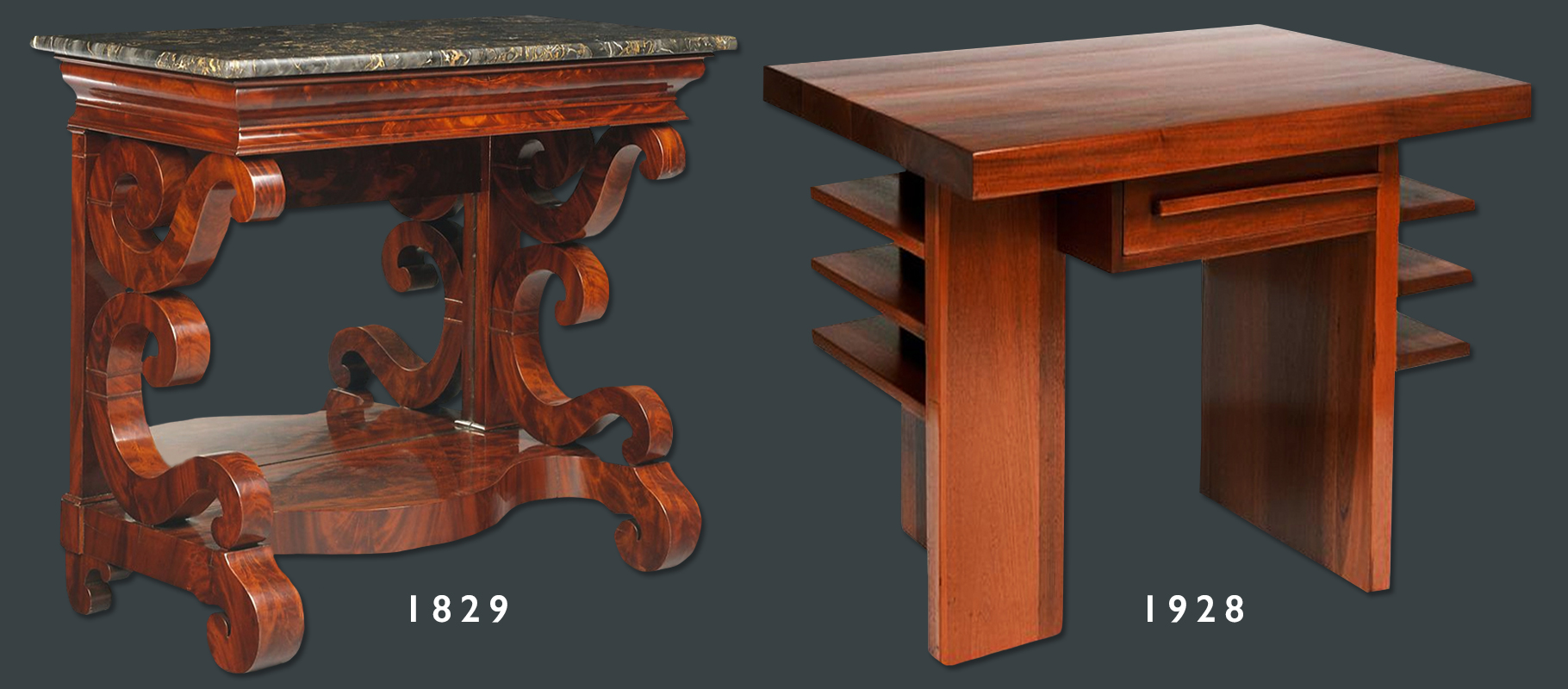 Above: a 19th century side table contrasted with a 20th century style
Above: a 19th century side table contrasted with a 20th century style 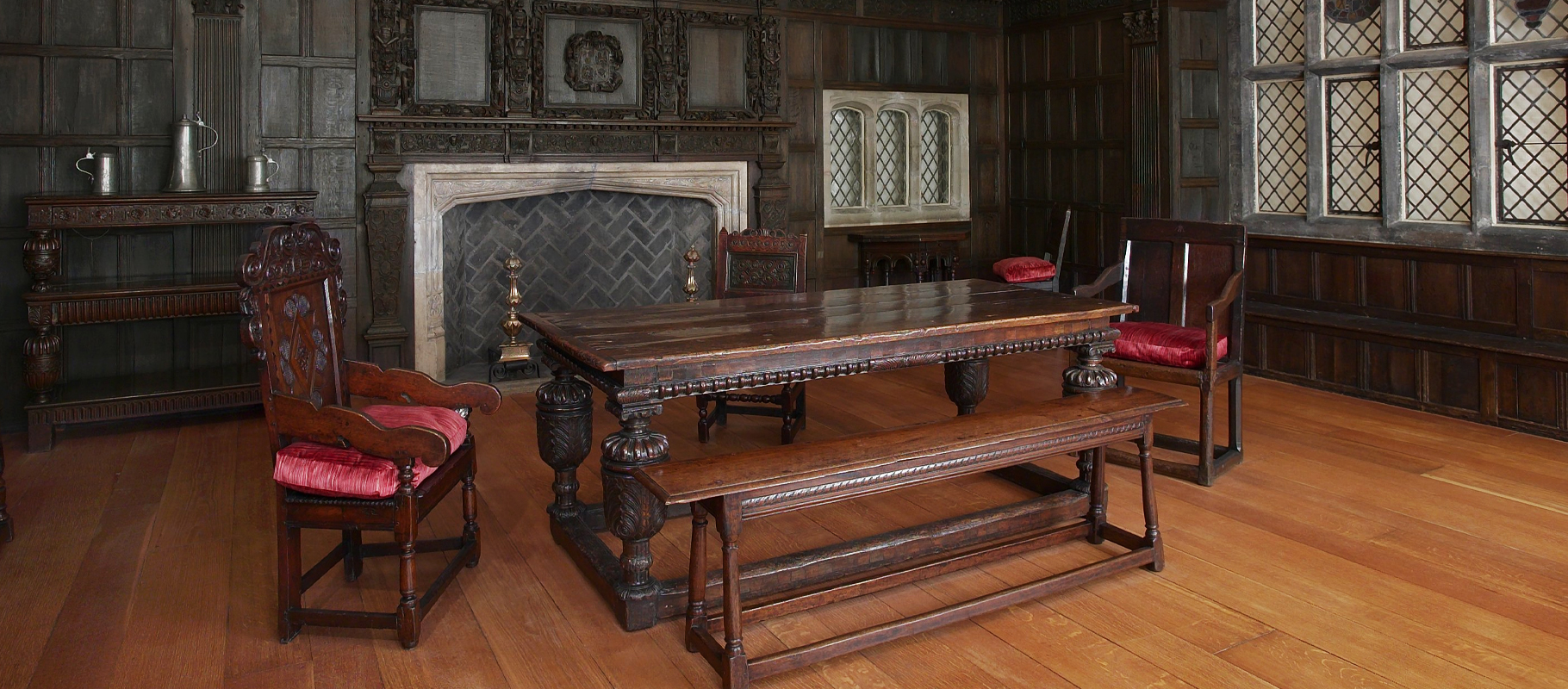 Above: an example of a late renaissance living space recreated in the Minneapolis Institute of Arts, the oak panels date to 1600
Above: an example of a late renaissance living space recreated in the Minneapolis Institute of Arts, the oak panels date to 1600 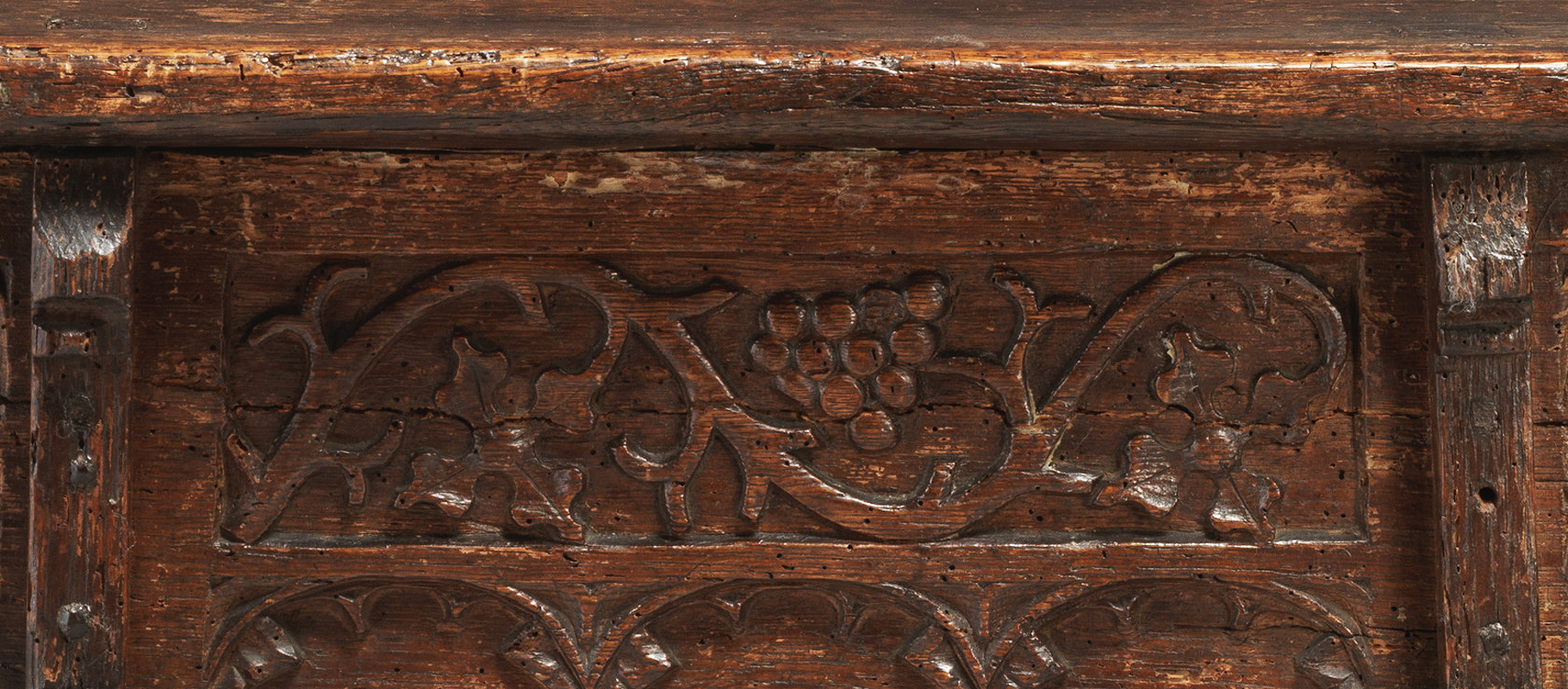 Above: grape motif carved on a 16th century British stool
Above: grape motif carved on a 16th century British stool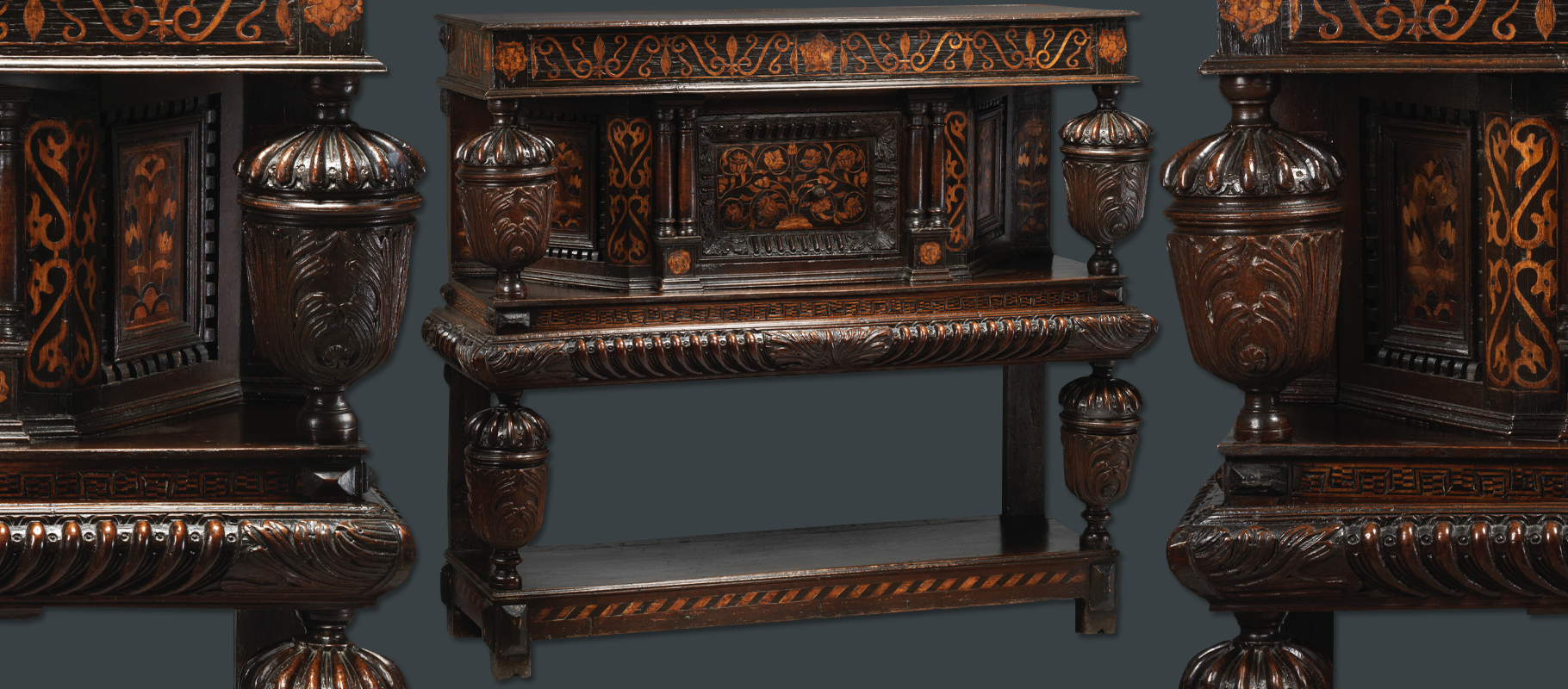 Above: a 16th century oak livery cupboard from 1585
Above: a 16th century oak livery cupboard from 1585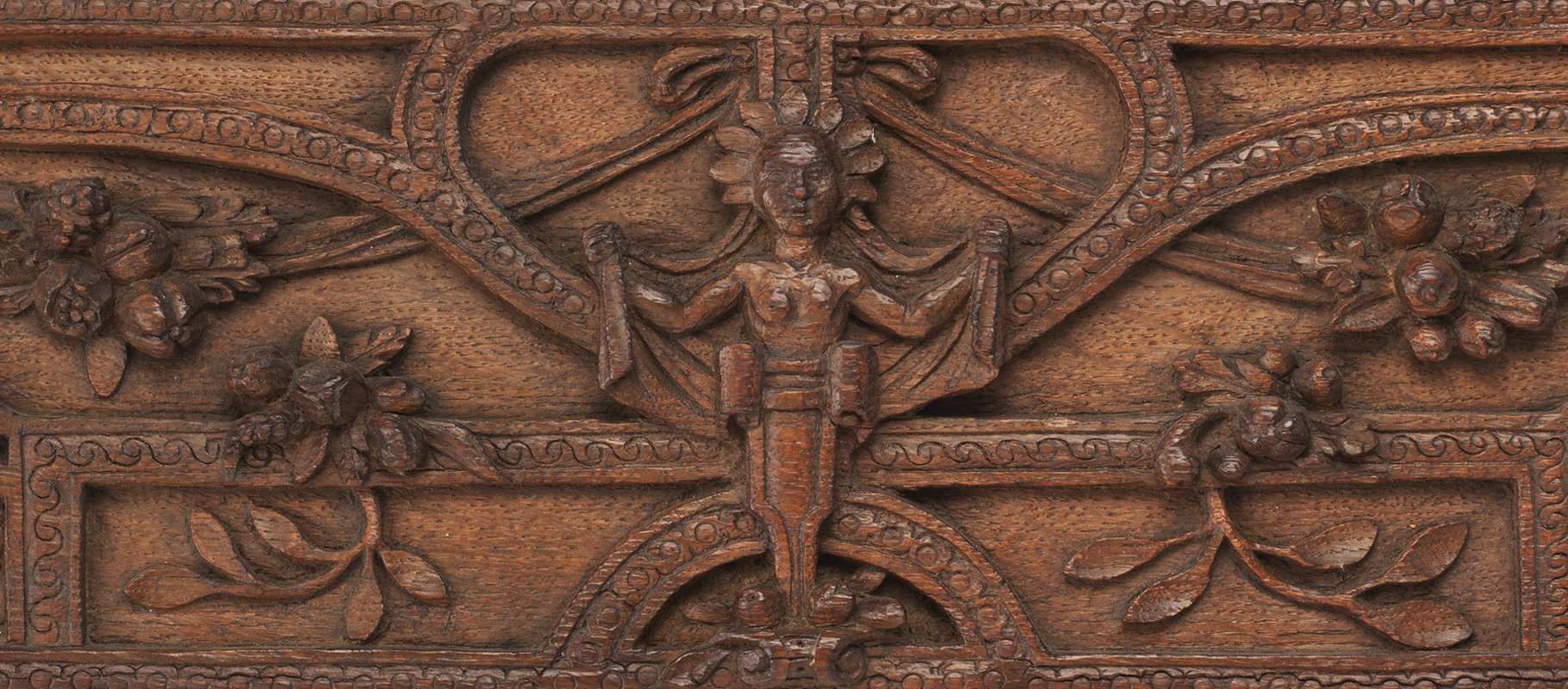 Above: a Dutch or Flemish oak panel, late 16th century
Above: a Dutch or Flemish oak panel, late 16th century Above: an Elizabethan oak document box, 1603
Above: an Elizabethan oak document box, 1603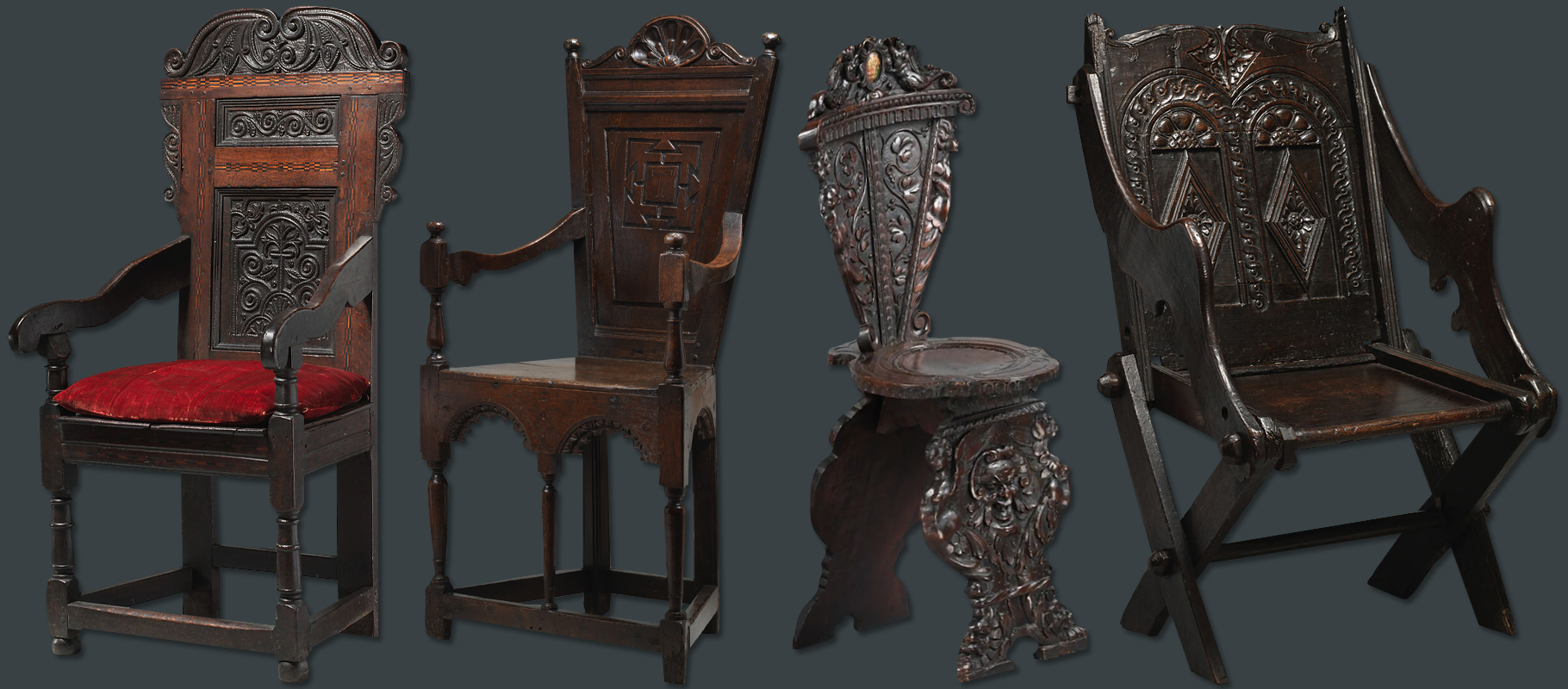 Above: a selection of 17th century chairs
Above: a selection of 17th century chairs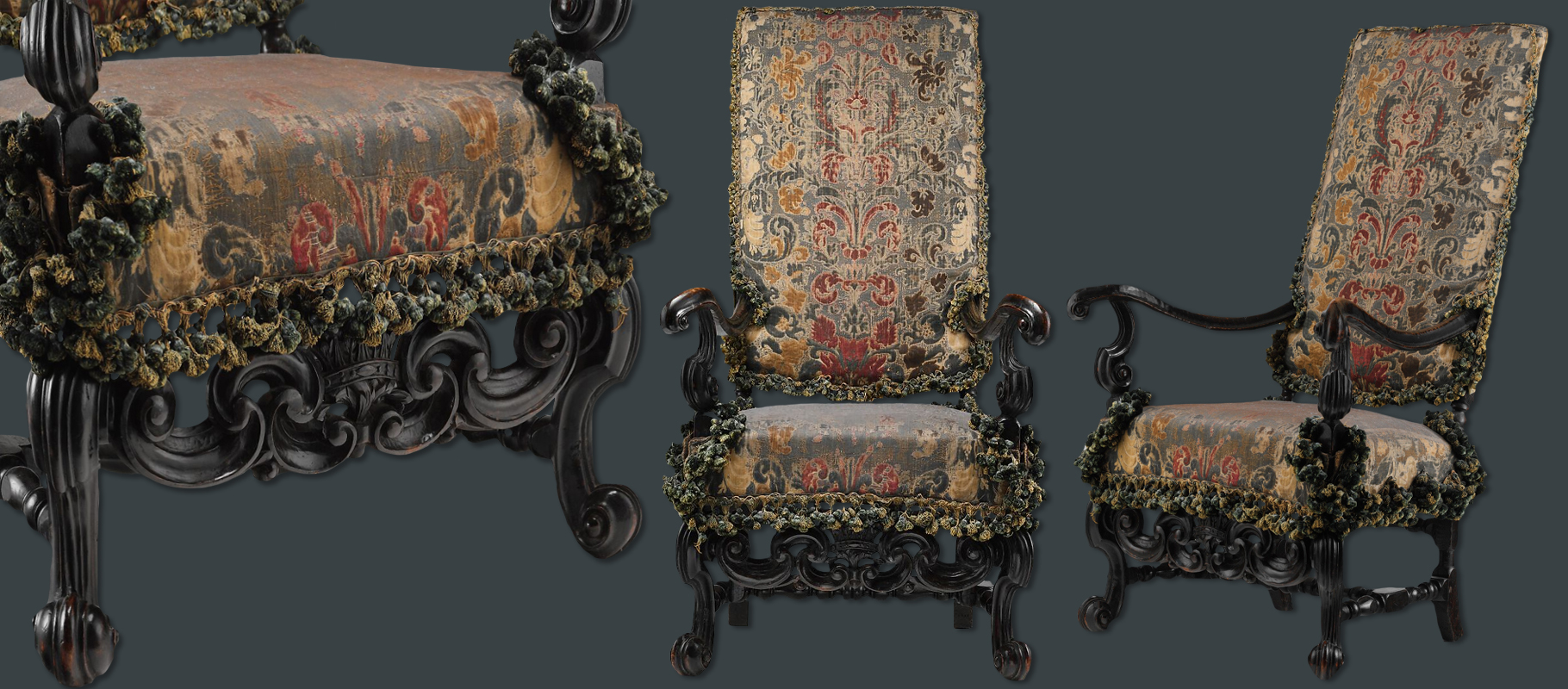 Above: a chair by Thomas Roberts in the style of Daniel Marot, 1689
Above: a chair by Thomas Roberts in the style of Daniel Marot, 1689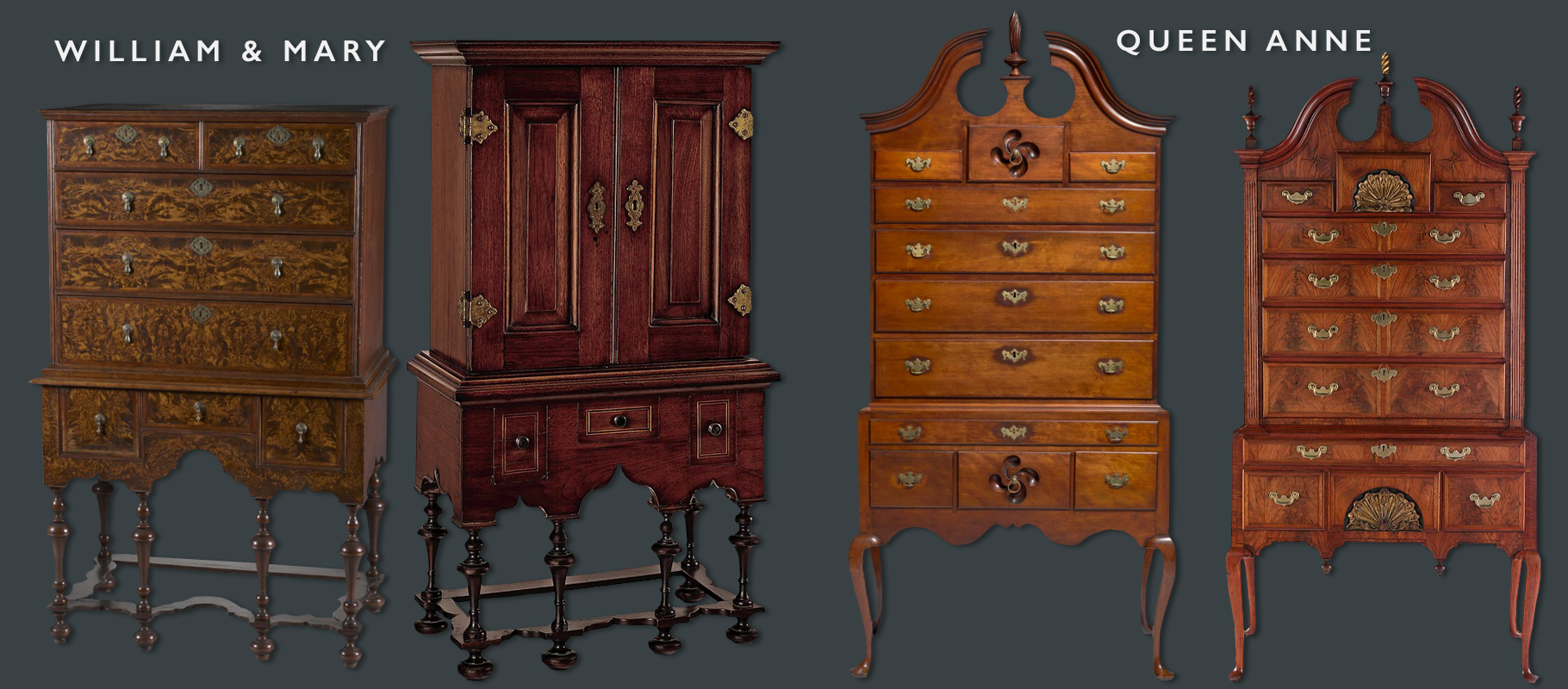 Above: high chest cabinets in William and Mary / Queen Anne styles
Above: high chest cabinets in William and Mary / Queen Anne styles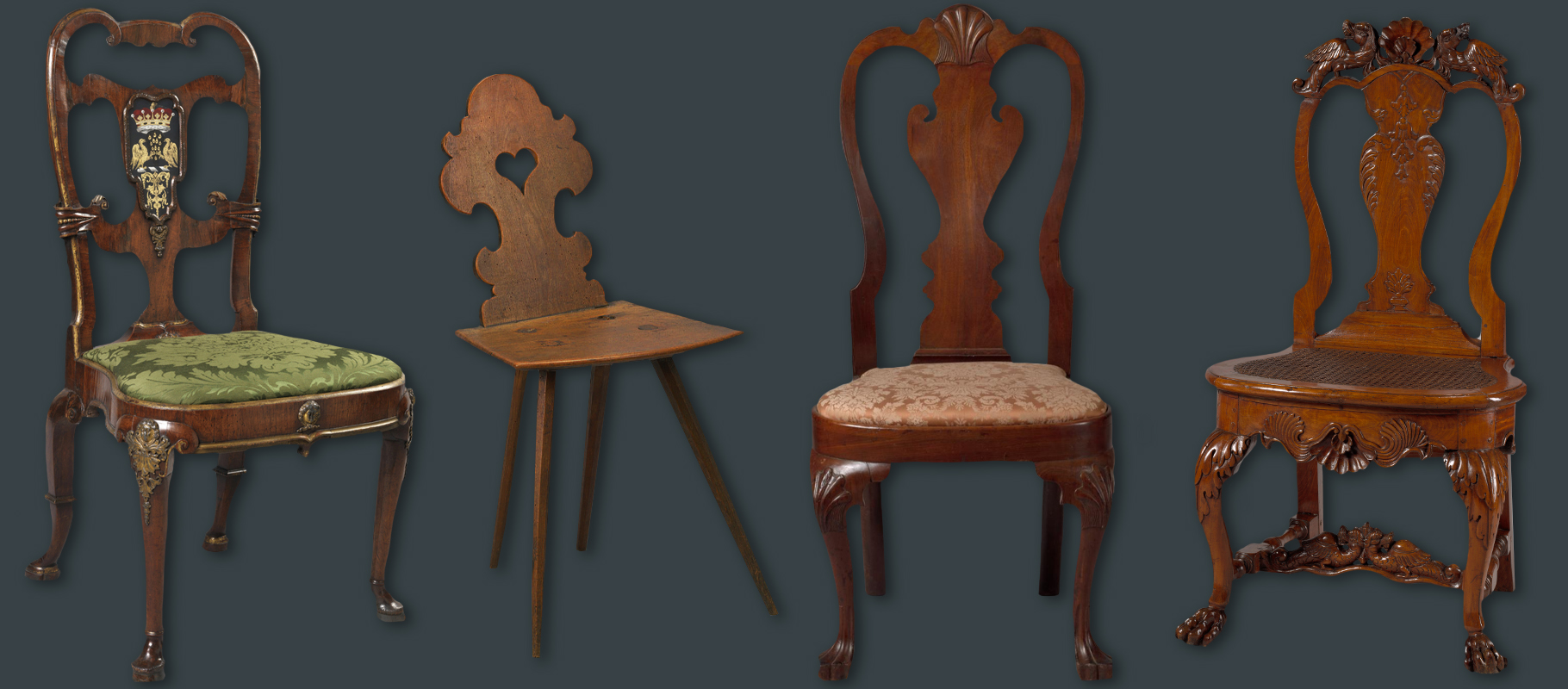 Above: early 18th century chairs with aspects of the Queen Anne style
Above: early 18th century chairs with aspects of the Queen Anne style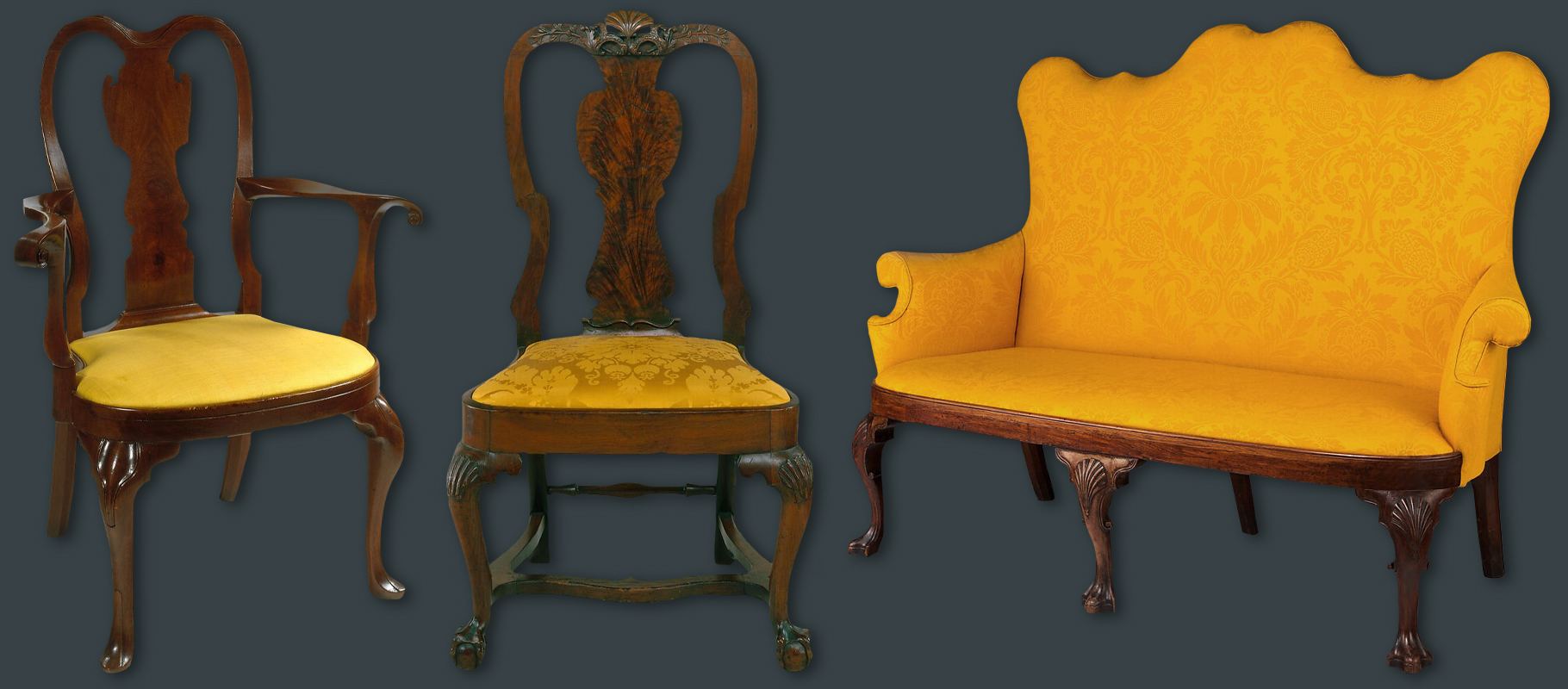 Above: a chair, settee, and armchair in the Queen Anne Style
Above: a chair, settee, and armchair in the Queen Anne Style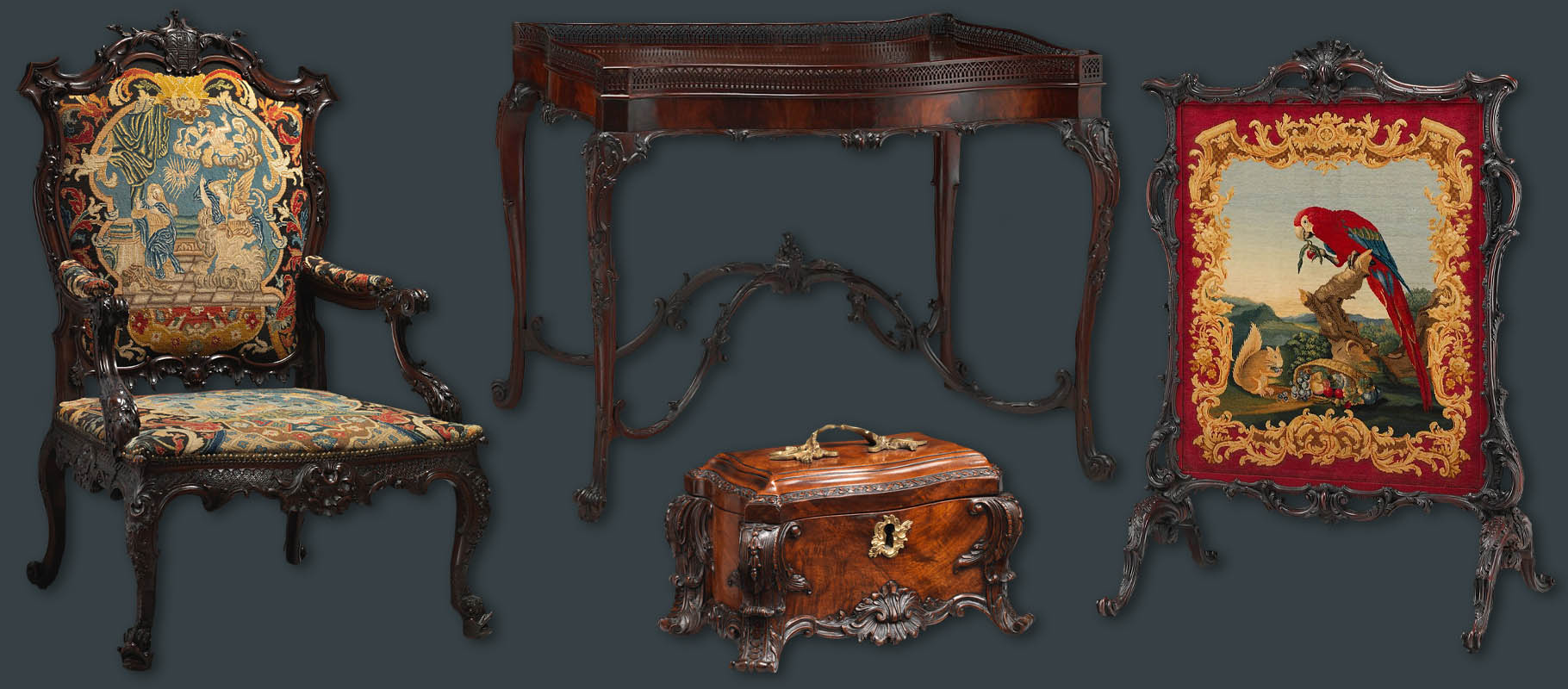 Above: examples of Chippendale furniture with upholstery including an armchair, two side chairs and a fireplace screen, all dating to the 18th century
Above: examples of Chippendale furniture with upholstery including an armchair, two side chairs and a fireplace screen, all dating to the 18th century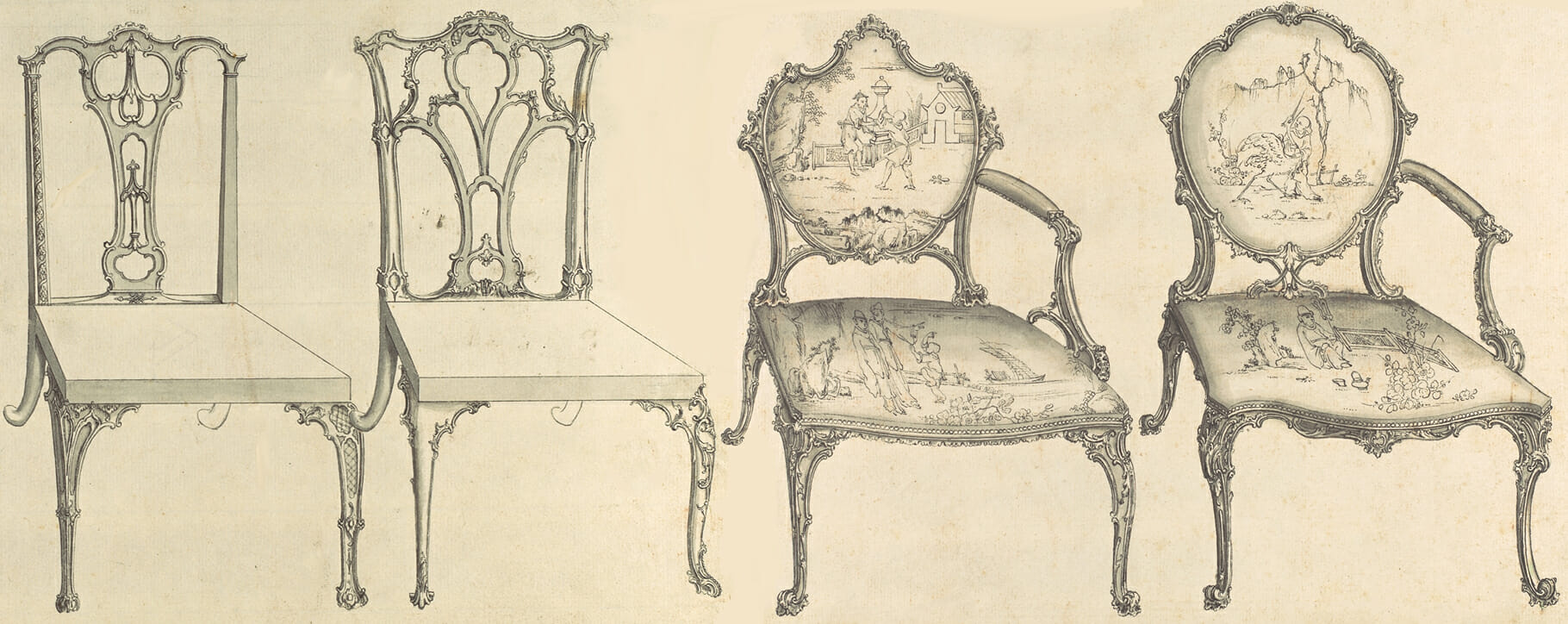 Above: a selection of chair designs by Thomas Chippendale from 1753 including two armchairs with chinoiserie upholstery
Above: a selection of chair designs by Thomas Chippendale from 1753 including two armchairs with chinoiserie upholstery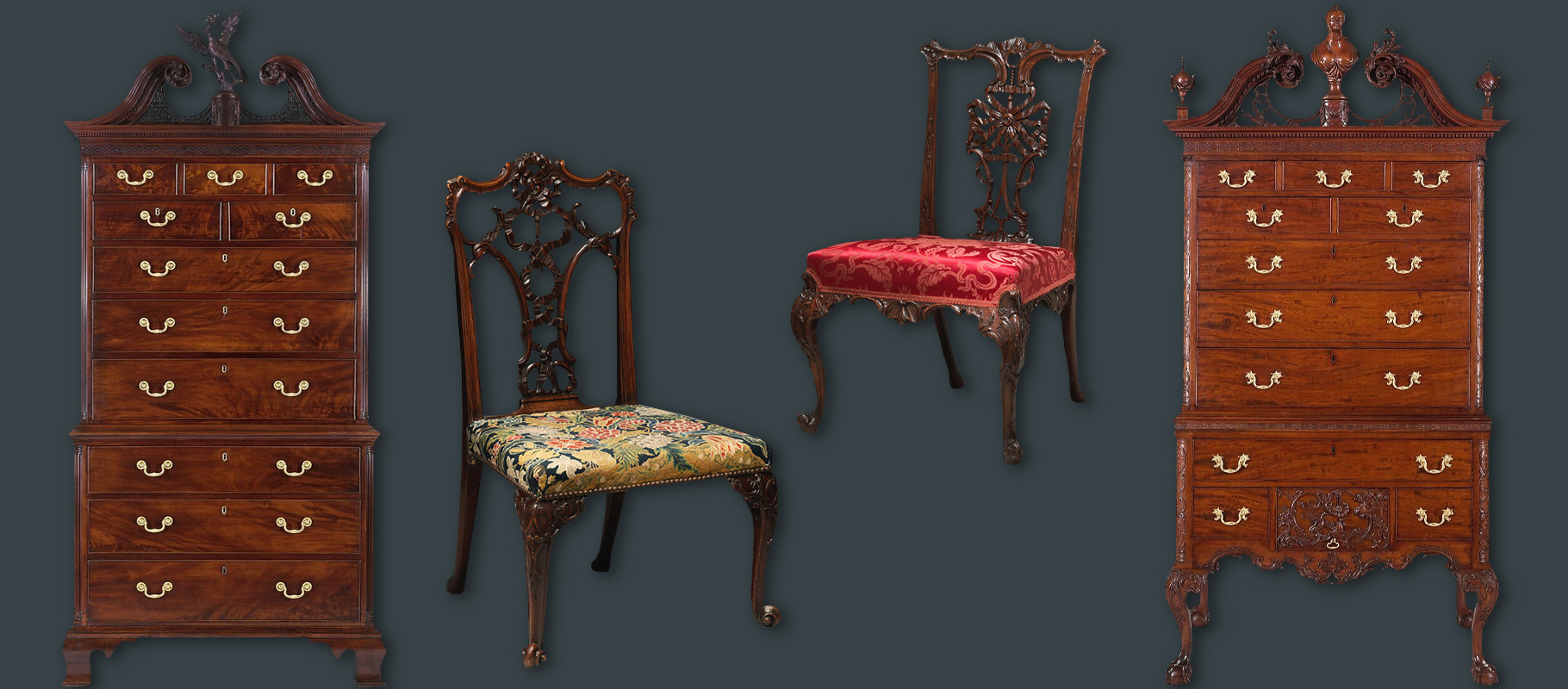 Above: a selection of furniture influenced by Thomas Chippendale’s Gentleman and Cabinet Maker’s Director
Above: a selection of furniture influenced by Thomas Chippendale’s Gentleman and Cabinet Maker’s Director 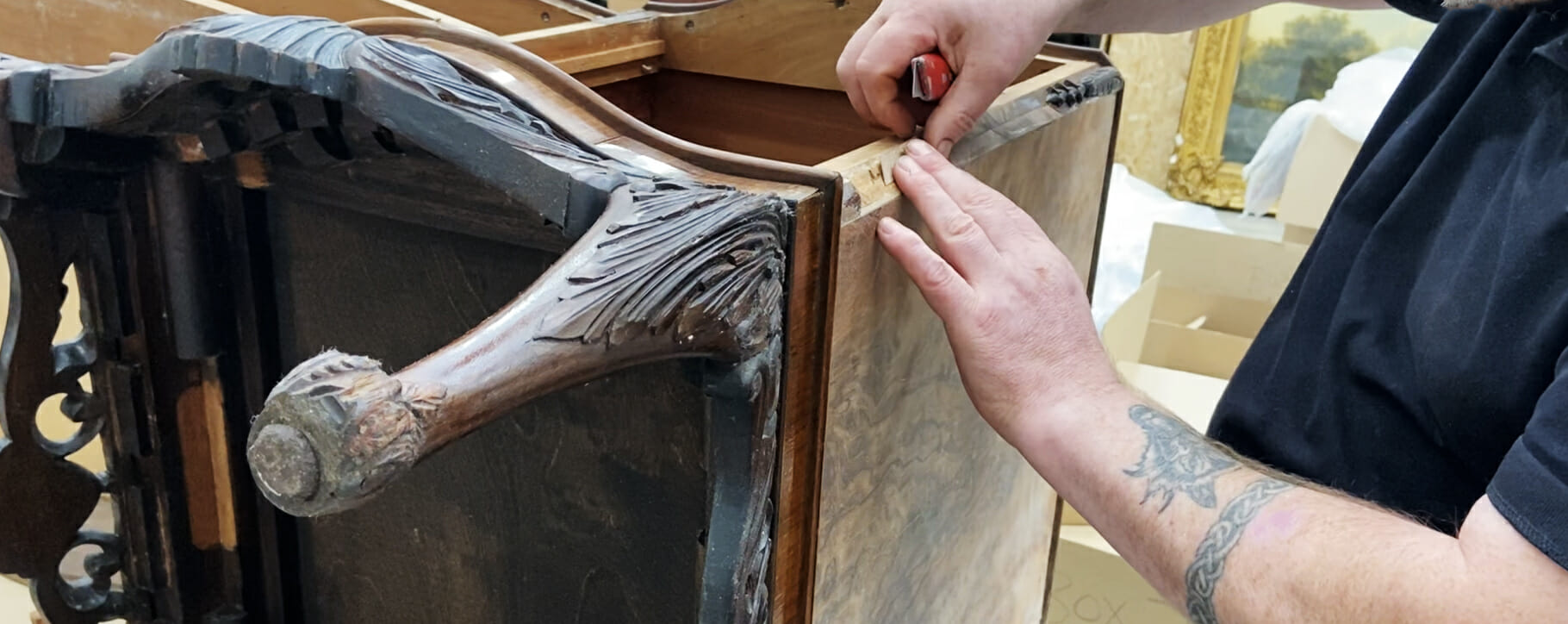 Above: our furniture restoration specialist restoring a herringbone veneer detail to a bureau with Chippendale features
Above: our furniture restoration specialist restoring a herringbone veneer detail to a bureau with Chippendale features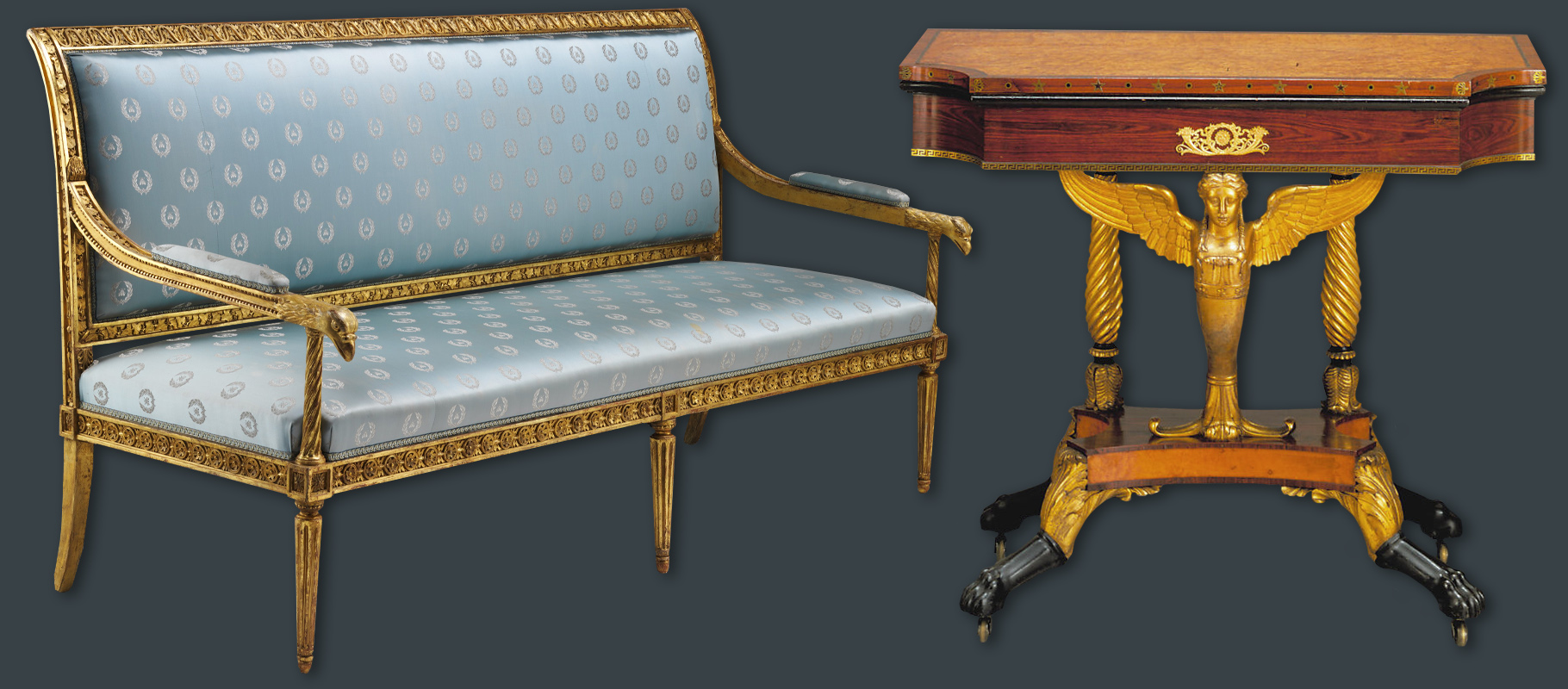 Above: a Russian settee from 1803 and an American card table attributed to Charles-Honoré Lannuier from 1810-19
Above: a Russian settee from 1803 and an American card table attributed to Charles-Honoré Lannuier from 1810-19 Above: three items attributed to famous Neoclassical designers including Charles-Honoré Lannuier, Robert Adam and Duncan Phyfe
Above: three items attributed to famous Neoclassical designers including Charles-Honoré Lannuier, Robert Adam and Duncan Phyfe Above: a group of Austrian neoclassical chairs with walnut veneers, 1830
Above: a group of Austrian neoclassical chairs with walnut veneers, 1830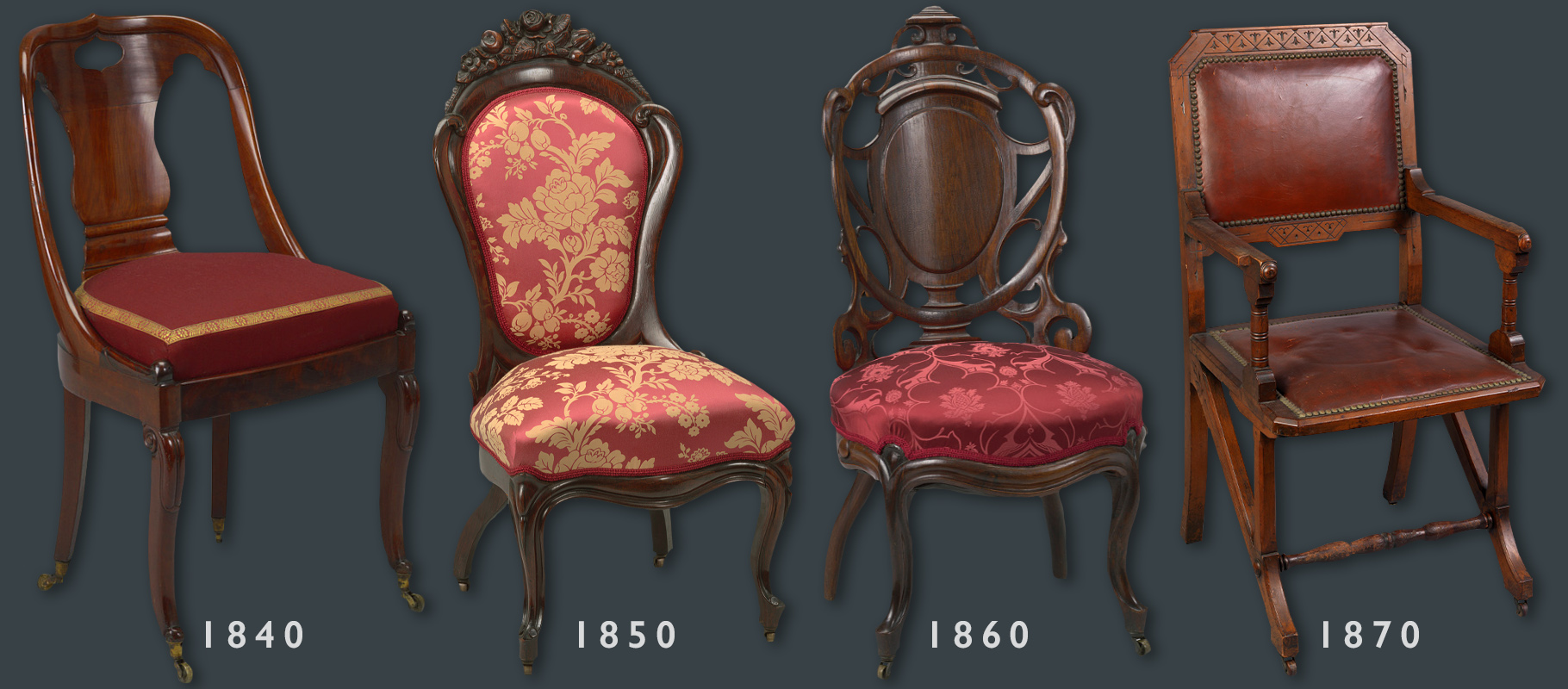 Above: a selection of 19th century chair designs from different decades
Above: a selection of 19th century chair designs from different decades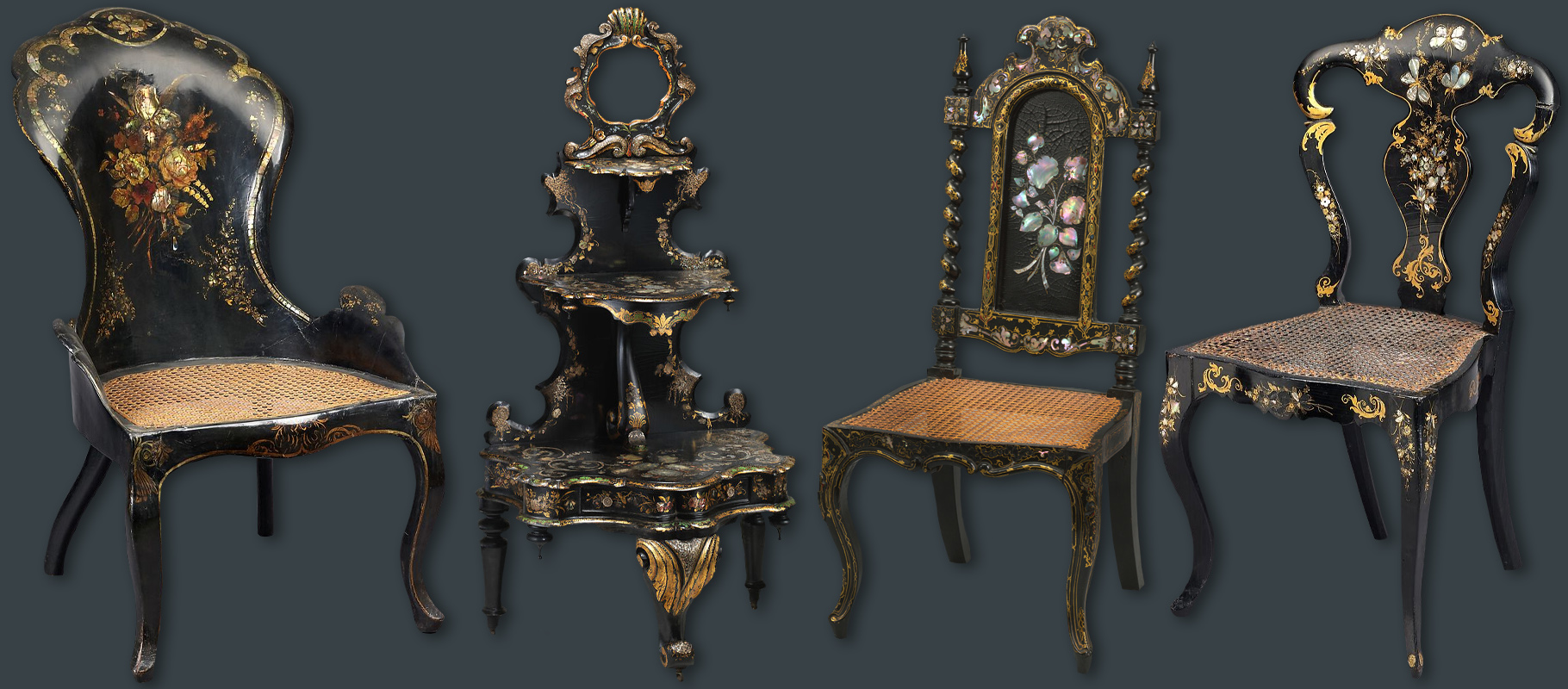 Above: various Victorian side chairs and an étagère made of lacquered papier-mâchè
Above: various Victorian side chairs and an étagère made of lacquered papier-mâchè  Above: gothic revival furniture and a 19th century birdhouse in the shape of a gothic style home
Above: gothic revival furniture and a 19th century birdhouse in the shape of a gothic style home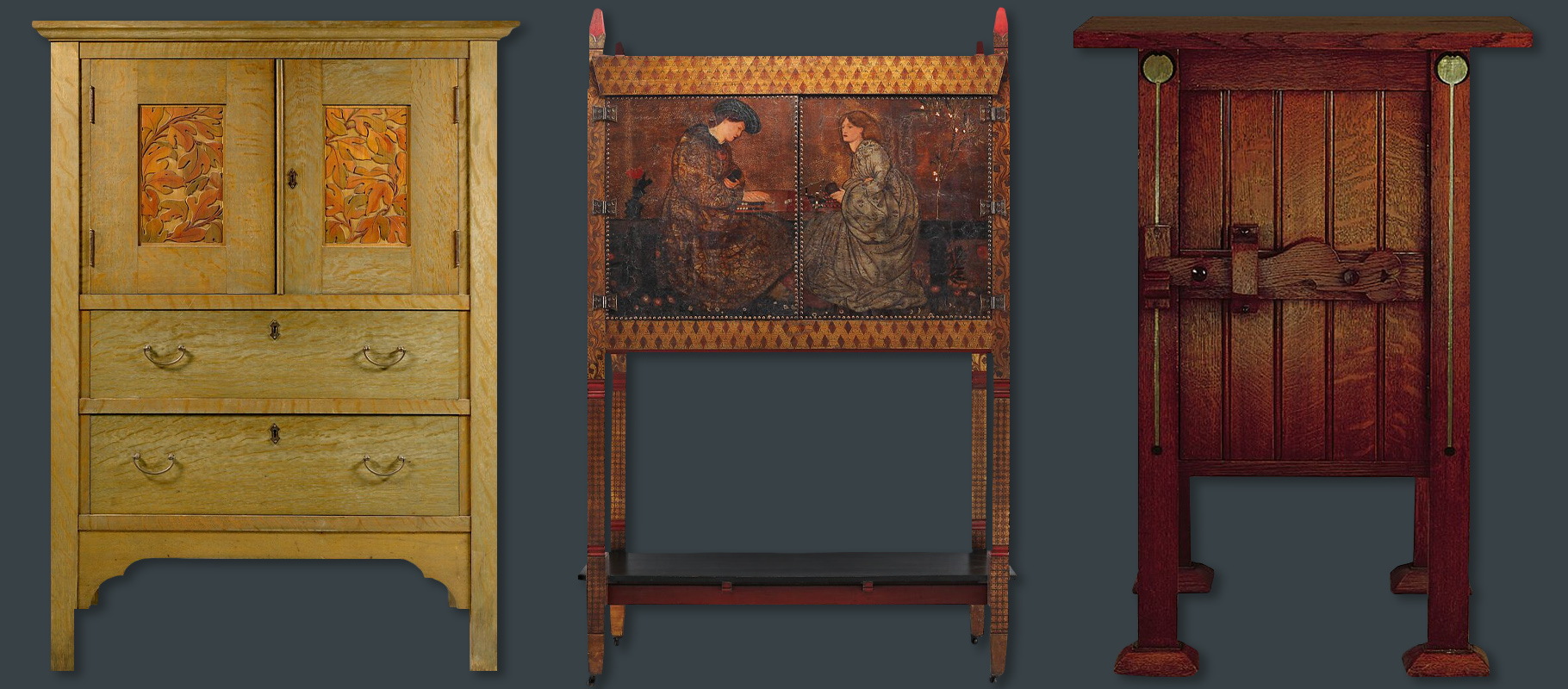 Above: examples of arts and crafts style furniture including an oak linen press, a William Morris cabinet with artwork by Edward Burne-Jones and a cabinet attributed to George Walton
Above: examples of arts and crafts style furniture including an oak linen press, a William Morris cabinet with artwork by Edward Burne-Jones and a cabinet attributed to George Walton Above: examples of mid-century Scandinavian furniture designs including a lounge chair and dining set
Above: examples of mid-century Scandinavian furniture designs including a lounge chair and dining set 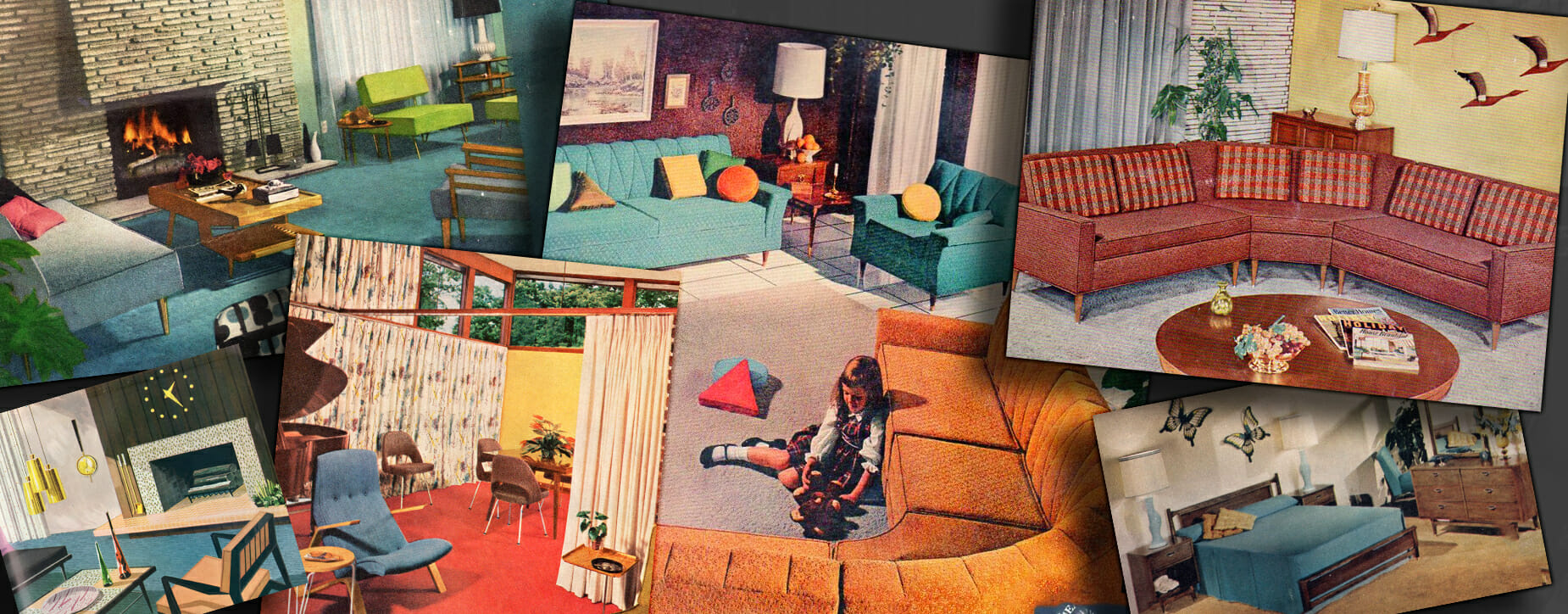 Above: mid-century home interiors featuring classic pieces of furniture from this era
Above: mid-century home interiors featuring classic pieces of furniture from this era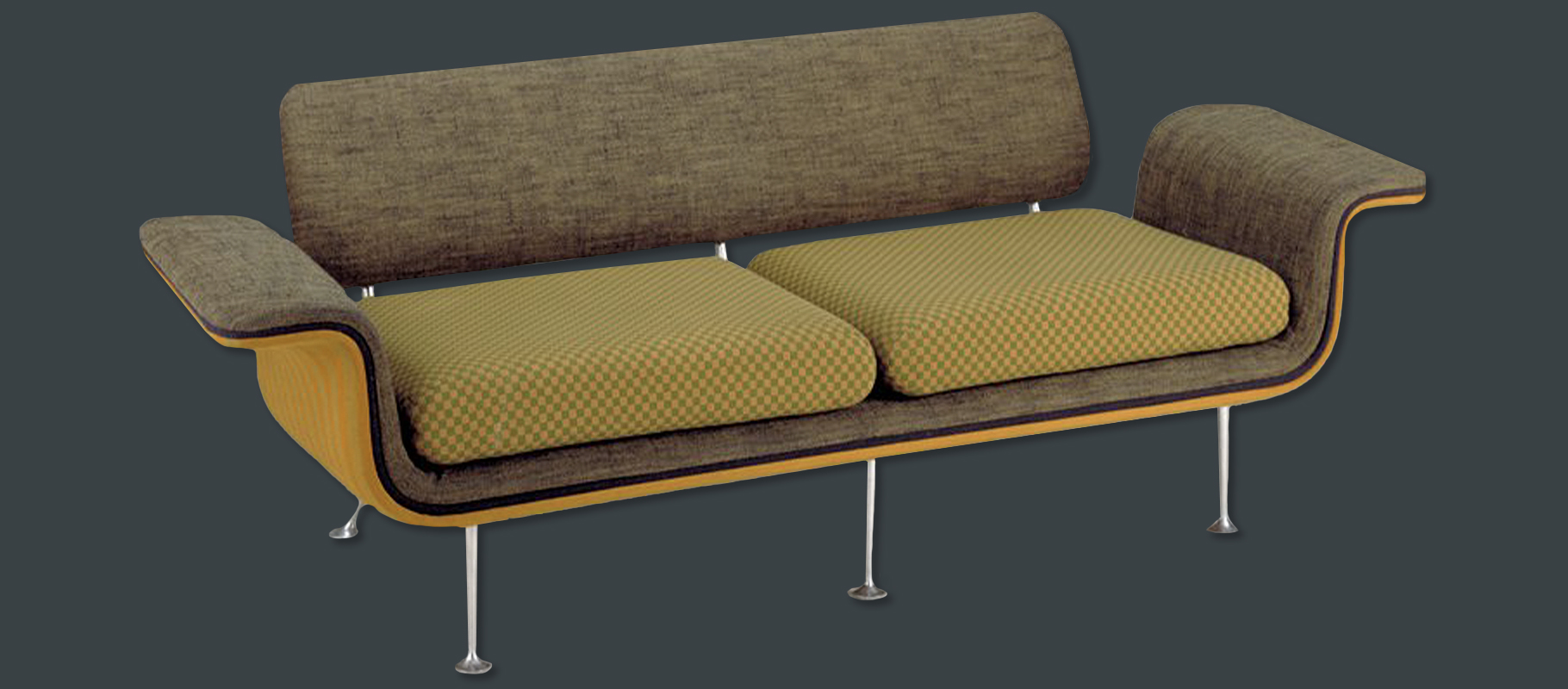 Above: a sofa designed by Herman Miller for an airline company, 1965
Above: a sofa designed by Herman Miller for an airline company, 1965 Above: two mid century living rooms
Above: two mid century living rooms




